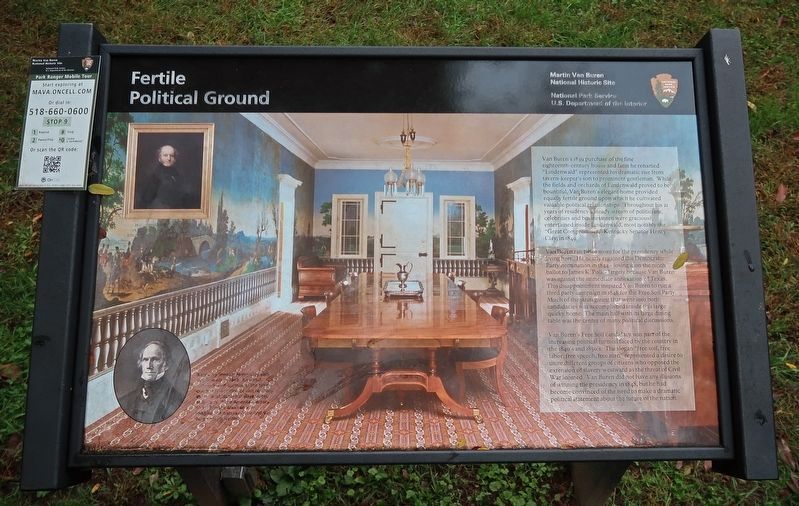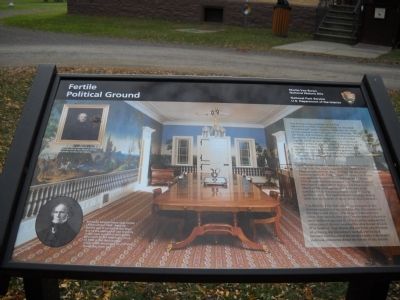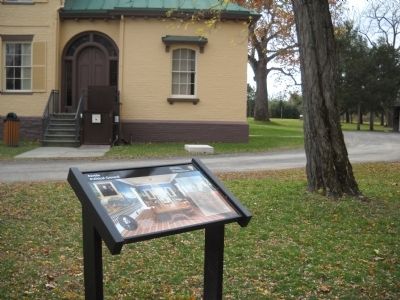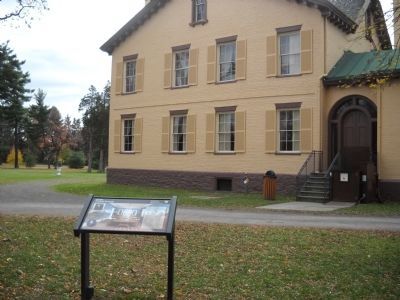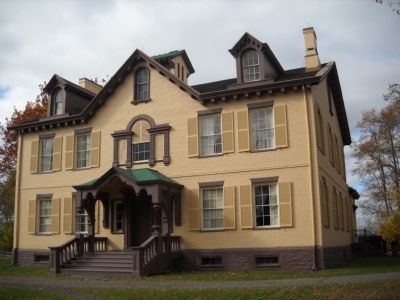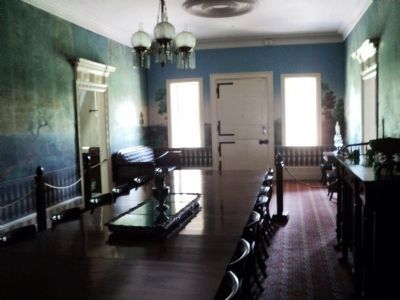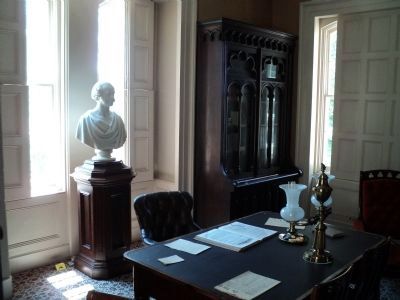Kinderhook in Columbia County, New York — The American Northeast (Mid-Atlantic)
Fertile Political Ground
Martin Van Buren Nat’l Hist Site
— National Park Service —
Van Buren’s 1839 purchase of the fine eighteenth-century house and farm he renamed “Lindenwald” represented his drastic rise from tavern-keeper’s son to prominent gentleman. While the fields and orchards of Lindenwald proved to be bountiful, Van Buren’s elegant home provided equally fertile ground upon which he cultivated valuable political relationships. Throughout his 21 years of residency a steady stream of politicians, celebrities and businessmen were graciously entertained inside Lindenwald, most notably the “Great Compromiser,” Kentucky Senator Henry Clay, in 1849.
Van Buren ran twice more for the presidency while living here. He nearly regained the Democratic Party nomination in 1844 – losing on the ninth ballot to James K. Polk – largely because Van Buren was against the immediate annexation of Texas. This disappointment inspired Van Buren to run a third party campaign in 1848 for the Free Soil Party. Much of the strategizing that went into both candidacies was accomplished inside this large quirky home. The main hall with its large dining table was the center of many political discussions.
Van Buren’s Free Soil candidacy was part of the increasing political turmoil faced by the country in the 1840’s and 1850’s. The slogan “free soil, free labor, free speech, free men” represented a desire to unite different groups of citizens who opposed the extension of slavery westward as the threat of Civil War loomed. Van Buren did not have any illusions of winning the presidency in 1848, but he had become convinced of the need to make a dramatic political statement about the future of the nation.
Erected by National Park Service.
Topics and series. This historical marker is listed in this topic list: Notable Buildings. In addition, it is included in the Former U.S. Presidents: #08 Martin Van Buren series list. A significant historical year for this entry is 1839.
Location. 42° 22.195′ N, 73° 42.221′ W. Marker is in Kinderhook, New York, in Columbia County. Marker is on Old Post Road, on the right when traveling south. Marker is on the grounds of the Martin Van Buren National Historic Site. Touch for map. Marker is in this post office area: Kinderhook NY 12106, United States of America. Touch for directions.
Other nearby markers. At least 8 other markers are within walking distance of this marker. 1849-50 A House Transformed (within shouting distance of this marker); Marble Mounting Block (within shouting distance of this marker); A Bustling Household (within shouting distance of this marker); Fallen White Mulberry Tree (within shouting distance of this marker); Lindenwald and the Old Post Road (within shouting distance of this marker); Lindenwald (about 300 feet away, measured in a direct line); Farm Operations (about 300 feet away); An Agrarian Lifestyle… (about 400 feet away). Touch for a list and map of all markers in Kinderhook.
More about this marker. The background of the marker contains a picture of the large dining table in the main hall of Lindenwald. The upper left of the marker features a painting of Van Buren and has a caption of “Artist Henry Inman painted this portrait of Martin Van Buren at the height of his political power in the mid-1930’s.” Below this is a portrait of Henry Clay and has a caption of “Kentucky Senator Henry Clay visited Lindenwald in 1849. National politics was in turmoil at the time due to the addition of vast territory in the west, potential slave states, as a result of the American victory of 1848 in the Mexican War. Imagine the discussions he and Van Buren may have had.”
Also see . . .
1. Biography of Martin Van Buren. The White House website entry (Submitted on November 11, 2010, by Bill Coughlin of Woodland Park, New Jersey.)
2. Martin Van Buren National Historic Site. National Park Service website homepage (Submitted on November 11, 2010, by Bill Coughlin of Woodland Park, New Jersey.)
3. Van Buren, Martin, National Historic Site - National Park Service. Download National Register of Historic Places documentation (Submitted on January 17, 2024, by Anton Schwarzmueller of Wilson, New York.)
Credits. This page was last revised on January 17, 2024. It was originally submitted on November 11, 2010, by Bill Coughlin of Woodland Park, New Jersey. This page has been viewed 822 times since then and 31 times this year. Photos: 1. submitted on October 12, 2021, by Duane and Tracy Marsteller of Murfreesboro, Tennessee. 2, 3, 4, 5. submitted on November 11, 2010, by Bill Coughlin of Woodland Park, New Jersey. 6, 7. submitted on June 23, 2012, by Bill Coughlin of Woodland Park, New Jersey.
